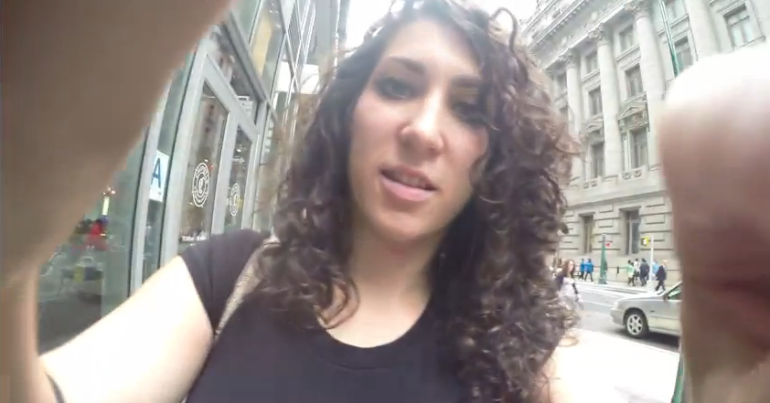The Catcalling Video's Message Is More Disturbing Than We Originally Thought

Whether it’s the catcall, the gaze, or the intrusion of personal space – for some reason women’s bodies become subjected to the whims of men as soon as we enter public spaces.
The worst part of all is that from a young age we have been taught just to “deal with it” because “it’s a part of life.”
But as I was looking at the catcall video, I thought to myself, “Finally! A video that will expose patriarchy for what it is – downright degrading and sexist. Finally, there’s a video bringing mass attention to the awkwardness and intimidation I feel every time I’m harassed by men.”
But Hollaback’s viral video offered me only a minimal sense of relief. Although it did address women’s harassment, it showed audiences that white women, specifically, experience sexual harassment from men. From which men? Black men. As a black person in America, I am exhausted that the black man must continuously be stereotyped as the hypersexual brute in media.
I mean, what is this "Birth of a Nation"?
Rob Bliss Creative, an ad agency that co-created the video, admitted to editing out white men from it. On Reddit, Bliss explained, “We got a fair amount of white guys, but for whatever reason, a lot of what they said was in passing, or off camera.” This post has now been deleted.
I’m sorry, but weren’t most of the men in the video “passing by” when they were catcalling?
Although Hollaback, an anti-harassment organization, issued an apology for their “unintentional racial bias,” I’m not quick to believe it. I believe the creators of the video used the image of the black man to get audiences to rally for the cause. Because what gets white Americans to rally for a cause more than a black man threatening a white woman’s “purity” and “femininity”?
The truth is, there have been many times when women of all ethnic backgrounds have been sexually harassed by white men - an issue that Jezebel writer and producer, Collier Meyerson, aims to address in a video responding to the viral catcall video.
Meyerson's response video features women of color talking about their experiences with harassment and how Hollaback's attempt at addressing street harassment heavily involves racial stereotyping.
Thanu, one of the participants, voiced her opinion on the original video.
“This is a video that’s being shown broadly and it gives the impression that the only predators in New York are men of color and that is false.”
Similar to my sentiments, Zoila and an unnamed participant expressed both how they have been harassed in other spaces than the street and how harassment from white men has been used to “exotify” women of color.
“I would say that I feel the most threatened by men when I’m out at a bar. And to be honest, it’s usually white guys that make me feel the most uncomfortable,” Zoila expressed.
“I feel like harassment from white men has been a form of exotifying me. A compliment isn't simply 'you're beautiful,' it has something do with my skin color, or my name, or 'where are you from?' I find that's a form of harassment because it makes me feel like my difference is interesting to them, and that creeps me out a lot more.”
There have been moments when I too have felt exotified by white men. The first and last time I partied on USC’s fraternity row - a space overwhelmingly dominated by whiteness – drunk white men would approach my friends and I, telling us how much they loved black girls. To them, we were “so cool,” “sexy” and we had “great hair.” And of course, they wanted to dance with us so they could rave about our butts.
Hollaback’s video shows the dangers of the viral video – especially one that seeks to relay a message onto an audience. Just because a video has gone viral, doesn’t mean it’s enlightening audiences with the complete truth of a situation or issue. It’s disappointing that the creators of the video used race to shed light on women’s harassment. By doing so, they isolate both women and men of color. The truth is, sexual harassment happens too often to women of all ethnic backgrounds. It can happen anywhere and the perpetrators can be men of equally diverse backgrounds.
I can’t wait for the day when White America runs out of creative and subliminal ways to use racial stereotyping as a means to describe problems in society. But I guess I’ll be waiting for a while.
Watch Hollaback's viral video below.
Reach Staff Reporter Jillian Baker here.



